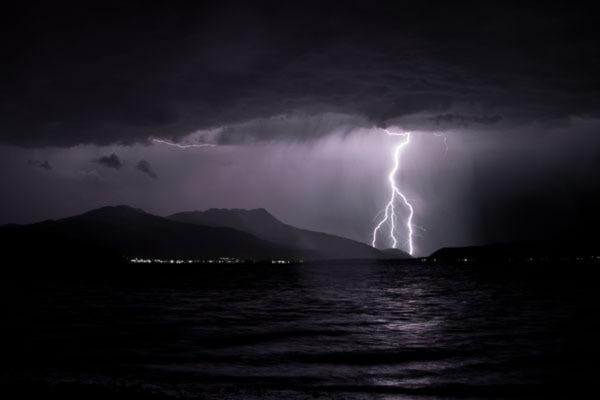For such an intense storm, Salmon Arm got off lucky with little to report in terms of damage or fires.
Last night's lightning storm was spectacular, but its power to spawn wildfires was dampened by the 35.8 mm of rain that fell on the city.
The Ministry of Forests weather station located at 20th Avenue and 40th St. measured 25.4 mm in one hour, while the Environment Canada station near the water treatment plant in Salmon Arm Bay measured only 10.8 mm of rain in the same period.
"That's a good amount of rain for one day anyway," says Environment Canada warning preparedness meteorologist Doug Lundquist, noting there were 2,800 lightning strikes in the Southern Interior between noon and midnight yesterday - 2,000 of them between 5 and 11 p.m. "Summer convective weather is very localized, thunderstorms are mostly random, especially in the Shuswap."
Originating in the eastern Pacific, the storm rumbled in from the south coast and moved on to Alberta and Saskatchewan.
"The heaviest amount of precipitation was in the Salmon Arm Fire Zone," says Kayla Pepper, a fire information officer with the Kamloops Fire Centre. "We had a total of 24 lightning-caused fires but because of the significant rain, they got washed out."
Only one wildfire survived in the Salmon Arm zone, a spot-sized fire in the mid-level elevation of Solsqua that was being dealt with this morning.
Local firefighters responded to three storm-related calls yesterday, one a hydro pole fire ignited by a lightning strike near the Home Restaurant at 9 a.m.
The other two calls came during the second and much more powerful evening storm.
Firefighters from Hall 2 responded to a call at the Holiday Inn at 9:30 p.m..
"A surge in power caused a malfunction in their elevator, trapping people inside," says Fire Chief Brad Shirley, who notes members of the fire department's rescue team were on the scene and had the people out in about 10 minutes.
The final call of the day came in at 11 p.m., when a tree located at 3741 30th St. NE was struck by lightning and burst into flames.
BC Hydro community relations rep Gene Bryant was also relieved the spectacular light show was accompanied by significant rainfall and very surprised only about 500 customers lost power for so short a period of time.
"All in all, there was minimal damage to the electrical system considering the intensity of the storm," he says, pointing out there were 13 power outages in Salmon Arm. "I am quite shocked and pleased, usually Salmon Arm gets hit pretty hard."
Bryant says the the outages occurred primarily between 9 and 10 p.m. and were small localized incidents involving trees landing on power lines.
"The good news is it appears there were no significant hits to the local system," he says, explaining how smaller sub stations are linked to larger local systems.
"For such an intense storm, we were very lucky."
Meanwhile, if you're heading out camping this weekend,
be advised that due to the extreme wildfire risk in the Lillooet and Merritt zones, campfires are now prohibited.
The ban applies to open fires of any size, including campfires, fires with a burn registration number and industrial burning, fireworks, tiki torches and burning barrels.
The Lillooet Fire Zone extends from the Bridge River Glacier west of Goldbridge east to Spences Bridge, and from French Bar Creek north of the Yalakom Valley to 22 km south of Lytton.
The Merritt Fire Zone extends from Spences Bridge east to Hedley, and from 11 km north of Nicola Lake to the U.S. border in the south (east of Manning Park to west of the Border Lake Trail).
